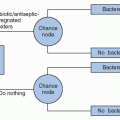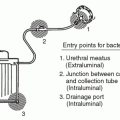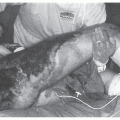INTRODUCTION
Although healthcare-associated infection (HAI) pathogens are most frequently transmitted to patients via the transiently contaminated hands of personnel, there has long been a concern that the inanimate hospital environment also may be a source of pathogens causing HAIs. The inanimate environment in healthcare facilities generally refers to environmental surfaces (including floors, walls, medical equipment and instruments, furniture, and other parts of the physical infrastructure), air, and water. The term “fomite” refers to an inanimate object that may become contaminated and may play a role in the transmission of pathogens.
The widely accepted Spaulding classification of medical equipment and patient-care items includes three categories based on the potential for the object to transmit infection if it becomes microbiologically contaminated before (or during) use (
1). These categories are “critical,” “semicritical,” and “noncritical.” Critical items, which come in contact with sterile tissue or the vascular system, and semicritical items, which come in direct contact with mucous membranes or nonintact skin, are discussed in
Chapter 20. Noncritical items are those that come into contact with intact skin, but not mucous membranes. The noncritical items can be divided into two categories: noncritical patient-care items and noncritical environmental surfaces (
2). Examples of noncritical patient-care items include blood pressure cuffs, bedpans, pulse oximeters, and crutches. Noncritical environmental surfaces include items such as bed rails, bedside tables, some food utensils, patient furniture, and floors (
3).
The environmental surfaces can be further classified into medical equipment surfaces (e.g., knobs or handles on hemodialysis machines, X-ray machines, instrument carts, and dental units) and housekeeping surfaces (e.g., floors, walls, and tabletops) (
1). The 2003 Centers for Disease Control and Prevention (CDC) environmental guideline introduced the term “high-touch housekeeping surfaces” (e.g., doorknobs, bed rails, light switches, wall areas around the toilet in the patient’s room, and the edges of privacy curtains) to refer to the objects that are touched more frequently by healthcare personnel and are presumably more likely to contribute to transmission (
1). The guideline also included extensive discussions of air and water quality. Recently, Huslage et al. conducted an observational study of healthcare workers (HCWs) in order to more clearly define high-touch surfaces (
4). Five surfaces were defined as high-touch surfaces: bed rails, the bed surface, supply carts, overbed tables, and intravenous pumps. The present chapter discusses noncritical objects that come into contact with intact skin (but not mucous membranes), air, and water.
ROLE OF ENVIRONMENTAL SURFACES IN THE TRANSMISSION OF PATHOGENS
For organisms in the inanimate environment to cause HAIs, a number of factors need to be present:
(a) An adequate number of pathogenic organisms must be present in the environment, (b) microorganisms must be virulent and capable of surviving in the environment, (c) a susceptible host must be exposed, (d) an appropriate mode of transmission or transfer of the organism in sufficient number from source to host, and (e) there must be an appropriate portal of entry into the host (
1,
21,
22,
23). The goal of this chapter is to review the evidence supporting the role of environmental surfaces, contaminated devices that come into contact with intact skin, water, and air as sources of transmission of pathogens to patients. The transmission related to contaminated dialysis equipment, medications, and devices that come into contact with sterile tissues or mucosal surfaces will be covered in other chapters.
Frequency of environmental surface contamination by pathogens. The frequency of contamination of the environment depends on a variety of factors, including the degree of shedding of the organism from the source, the ability of the organism to survive in the environment, the ability to culture the organism, the sampling and processing methods used to recover the organism, the susceptibility of the organism to standard detergents and disinfectants, the ease with which contaminated items can be disinfected, the adequacy of routine housekeeping practices, and whether or not an outbreak is occurring at the time of sampling (
23). Many studies have documented that patients are the major source of environmental contamination in patient-care areas (
17,
18,
19,
20,
24,
25). HCWs also can contaminate the environment, but to a lesser degree than patients (
26,
27,
28). The frequency and number of organisms shed by patients into the environment depends in part on the type and number of body sites colonized or infected with the pathogen, and probably to the level of activity of the patient and those caring for the patient (
7,
17,
18,
19,
25,
29,
30,
31). For example, studies conducted in the 1950s and early 1960s documented that a patient with a staphylococcal carbuncle contaminated linens, floors, and nearby medical equipment in the patient’s room (
7). Rutala et al. documented surface contamination with MRSA in the rooms of affected burn patients (
32). In a study of patients with MRSA nasal colonization, 15% of patients had contaminated their environment within 25 hours of admission, and 25% had contaminated the surfaces within 33 hours of admission (
33). Patients with MRSA colonization or infection contaminate from a few percent to 74% of surfaces in their environment, with higher levels and frequency of contamination in patients with MRSA in their urine or in a wound, or with heavy gastrointestinal colonization accompanied by diarrhea (
17,
31,
34). Patients colonized with VRE contaminate from 7% to 71% of surfaces in their rooms, with the greatest levels of contamination occurring in those with colonization at several body sites or with diarrhea (
18,
19,
29,
30). Among Gram-negative pathogens,
Acinetobacter spp. is particularly likely to survive on environmental surfaces, even if the surfaces are dry (
35,
36,
37). Environmental contamination is frequent even when the patient has a remote history of
Acinetobacter spp. colonization or infection (
37). The frequency of
C. difficile environmental contamination varies from 29% among asymptomatic carriers to 49% to 100% in patients with symptomatic
C. difficile-associated diarrhea (CDAD) (
20,
30,
38,
39). Patients with CDAD continue to have skin colonization and contaminate their environment even after their diarrhea has abated (
25). Patients with acute norovirus or astrovirus infection shed large numbers of viral particles into their environment (
40,
41).
Microorganisms must be virulent and capable of surviving in the environment. Environmental surfaces in healthcare facilities often have some level of contamination by bacteria that have a low level of virulence or are nonpathogenic. A few examples include
Bacillus sp., diphtheroids, and some species of coagulase-negative Staphylococcus. In most instances, a finding of such bacteria on environmental surfaces is of little clinical significance. However, a variety of pathogens can survive for days, weeks, or even months on dry surfaces (
42,
43,
44). Gram-positive organisms including Enterococcus,
S. aureus,
Streptococcus pyogenes, and
C. difficile can survive for weeks to months on inanimate surfaces (
42,
43).
C. difficile spores can survive up to 5 months on dry surfaces (
45). Gram-negative bacilli are generally felt to survive less well in dry environments than Gram-positive organisms (
43). However,
Acinetobacter spp. appears to survive for longer time periods than other Gram-negative bacilli, perhaps due to the unique characteristics that protect it from desiccation (
46,
47).
The survival of an organism in the environment does not necessarily mean that it will remain virulent and cause disease in humans. For example, Perry et al. found that
S. pyogenes subjected to desiccation were unlikely to cause pharyngitis (
48). Studies of
S. aureus and
C. difficile provide the most compelling evidence that pathogens recovered from inanimate surfaces can cause disease. Colbeck found that sutures inoculated with
S. aureus and allowed to dry for 10 to 14 days were still capable of causing abscesses (
49).
C. difficile spores routinely cause fatal enterocolitis in hamsters, and it is generally accepted that CDAD in humans is related to ingestion of spores, since the vegetative form of
C. difficile dies rapidly on dry surfaces (
50,
51).
A susceptible host must be exposed. Recent efforts to reduce the length of hospital stays and to deliver more healthcare
in outpatient and home settings has resulted in a greater severity of illness among hospitalized patients (
52). Advances in cancer chemotherapy and organ transplantation, and the type and number of invasive diagnostic and therapeutic procedures that patients undergo have resulted in an increasing number of patients with heightened susceptibility to HAIs. The widespread use of broad-spectrum antimicrobial agents in healthcare facilities puts patients at increased risk of developing infections due to multidrug-resistant organisms (MDROs), including those that survive in the inanimate environment (
53,
54,
55,
56).
An appropriate mode of transmission or transfer of the organism in sufficient number from source to host. Microorganisms may be transmitted directly from the environment to patients, or, more commonly, are transmitted indirectly from the environment to patients. For example, Bonten et al. found that a few patients acquired VRE after the same strain of VRE was found on their bedside rails, suggesting direct transmission from the environment to the patients (
19). Hardy et al. proposed that patients acquired MRSA directly from contaminated environmental surfaces, but did not entirely exclude transmission by HCWs (
57). Weist et al. provided evidence that an outbreak of methicillin-susceptible
S. aureus infection was associated with a contaminated ultrasound gel to which affected neonates were exposed (
58). One outbreak provided substantial evidence that MRSA was transmitted from contaminated ultrasonic nebulizers to patients via airborne or aerosol transmission (
59). Other investigations have suggested that MRSA was transmitted by the airborne route from contaminated ventilation grills to patients (
60,
61). Contaminated thermometers that came into direct contact with patients have been implicated as the source of VRE and
C. difficile infection (
62,
63,
64). Direct or indirect transmission of
Acinetobacter spp. to patients has been reported to occur from a variety of environmental sources, including mattresses, pillows, curtains, faucet aerators, water baths used for heating peritoneal dialysis solutions, bedside humidifiers, pressure transducers, respiratory therapy and hydrotherapy equipment, devices used for pulsatile wound therapy, and other environmental surfaces (
35,
36,
65,
66,
67,
68,
69,
70,
71).
There is increasing evidence that HCWs can contaminate their hands or gloves by touching contaminated environmental surfaces, even when they have no direct contact with the affected patients (
17,
20,
23,
72,
73,
74). And the greater the frequency of environmental contamination, the more likely it is that HCWs will contaminate their hands or gloves (
20,
75). The above studies suggest that HCWs whose hands have become transiently contaminated by touching inanimate surfaces may represent a common mode of transmission of organisms from the environment to susceptible patients. One study found that VRE were transferred from contaminated sites in the environment or on patients’ intact skin to clean sites via HCWs’ hands or gloves in 10.6% of opportunities (
76). Touching a contaminated item (e.g., blood pressure cuff) was as likely to transmit VRE to a sterile surface as touching a colonized patient. In a study by Hayden et al., >50% of HCWs touched both the patient and the patient’s environment; no HCW touched only the patient (
74). Of the 103 HCWs whose hand samples were negative for VRE when they entered the room, 52% contaminated their hands or gloves after touching the environment, and 70% contaminated their hands or gloves after touching the patient and the environment (
P = 0.001). Thirty-seven percent of HCWs who did not wear gloves contaminated their hands, and 5% of HCWs who wore gloves did so. The authors concluded that HCWs were nearly as likely to have contaminated their hands or gloves after touching the environment in a room occupied by a VRE-colonized patient as after touching the colonized patient and the patient’s environment (
74).
There must be an appropriate portal entry into the host. Invasive procedures—such as placement of central or peripheral intravenous catheters, indwelling bladder catheters, and endotracheal tubes—surgical incisions that disrupt the integrity of the skin, and cutaneous ulcers can all serve as portals of entry of pathogens into a susceptible host.
In addition to the factors cited above, there are several other lines of evidence that support the role of environment in the transmission of HAI pathogens. One indirect type of evidence that has emerged in recent years relates to the risk of acquisition of pathogens that is attributed to poor cleaning/disinfection of patient rooms following their discharge from the hospital (terminal cleaning).
Prior room occupancy as a risk factor for pathogen acquisition. One case-control study and five cohort studies have found that admission to a room previously occupied by a patient with a resistant pathogen (e.g., VRE, MRSA,
C. difficile) is an independent risk factor for acquisition of these bacteria by subsequent room occupants (
77,
78,
79,
80,
81,
82,
83) (
Table 19.1). For example, a case-control study conducted in a medical intensive care unit (MICU) used multivariate analysis to demonstrate that patients who acquired VRE were significantly more likely to have been admitted to a room with surfaces that remained contaminated even after terminal cleaning (
77). Huang et al. estimated that such exposures accounted for about 7% of new VRE episodes and 5% of MRSA episodes (
78). Subsequently, Drees et al. found that a VRE-colonized prior room occupant, any VRE-colonized room occupant within the previous 2 weeks, and previous positive room-culture results remained as the independent predictors of VRE acquisition (
79). More recently, Passaretti et al. reported that the risk of acquiring an MDRO from prior room occupants was reduced by effectively decontaminating the rooms using standard cleaning supplemented by hydrogen peroxide decontamination (
83). Because multiple studies have documented suboptimal disinfection of rooms following discharge of patients, it is likely that direct transmission from the environmental surfaces to newly admitted patients may occur.
Alternatively, residual room contamination could result in the contamination of the hands or gloves of HCWs caring for newly admitted patients. In contrast to the six studies mentioned above, one small study failed to find an association between prior room occupancy by an MRSA-positive patient and acquisition by subsequent patients, perhaps due to the small study size (
84).
Decontamination or removal of the implicated source results in the elimination of infection transmission. A number of studies have reported that decontamination or removal of an implicated source has resulted in the elimination of transmission of pathogens. Examples include decontamination or removal of a contaminated operating room roll board, pillows or mattresses, cloths, a topical cream preparation, skin lotion, ultrasound gels, and soap (
65,
66,
69,
85,
86,
87,
88,
89,
90,
91,
92,
93).
Improved cleaning and disinfection practices is associated with reduced acquisition or infection. A number of studies have shown that disinfection of environmental surfaces potentially contaminated with
C. difficile or VRE can lead to decreases in
acquisition or infection caused by these organisms (
82,
83,
94,
95,
96,
97,
98,
99,
100). For example, improved disinfection of surfaces using diluted bleach solutions or bleach wipes has resulted in reduced
C. difficile transmission, particularly on high-incidence wards (
94,
95,
97,
100). In one of the best studies of its kind, Hayden et al. provided convincing evidence that reducing VRE environmental contamination resulted in reduced acquisition of the organism by susceptible patients (
98). In an intervention study by Perugini et al., education of HCWs and reduction in the proportion of environmental and equipment that were contaminated with VRE were associated with a significant decrease in VRE infection (
99).
In a before-after intervention study, Boyce et al. found that decontamination of hospital rooms using hydrogen peroxide vapor (HPV) was associated with a significant reduction in the rate of
C. difficile HAIs (
96). While the study showed that HPV was effective in eradicating
C. difficile from a limited number of patient rooms, the authors did not determine if the reduction in CDAD was accompanied by a hospitalwide reduction in
C. difficile environmental contamination. A study by Datta et al. demonstrated that increased attention to room cleaning significantly reduced the risk of patients acquiring MRSA when they were admitted to a room previously occupied by an MRSA-positive patient, and also reduced to a lesser extent the risk of patients acquiring VRE from a previous room occupant (
82). Recently, the study by Passaretti et al. cited above found that patients admitted to rooms that were decontaminated using HPV were 64% less likely to acquire any MDRO (incidence rate ratio [IRR] = 0.36,
p < .001) and 80% less likely to acquire VRE (IRR = 0.20,
p < .001) after adjusting for potential confounding variables, such as hospital unit, age, mortality risk score, HIV status, end-stage renal disease status, compliance with MDRO surveillance procedures, and calendar time (
83). The risk of acquiring MRSA, multidrug-resistant Gram-negative rods (MDR-GNR), or C. difficile were each reduced as well, but not significantly. Another interesting finding was that HPV decontamination reduced the risk of MDRO acquisition even when the prior room occupant was not known to be MDRO-colonized or infected. This finding suggests that one or more of the prior room occupants may have been unidentified MDRO carriers.
Strength of evidence supporting the role of environmental surfaces in transmission. Most of the studies supporting the role of environment in the transmission of HAI pathogens have been conducted in acute care facilities, with fewer investigations conducted in hemodialysis units or long-term care facilities. Supporting studies fall into several categories, with some studies providing more compelling evidence than others.
There are few randomized trials dealing with the role of environmental surfaces in the transmission of HAI pathogens. Recently, a randomized controlled trial compared antimicrobial privacy curtains with standard curtains, and found that the antimicrobial curtains increased the time to first contamination (
101). Another recent randomized, prospective unblinded study of the impact of daily cleaning of high-touch surfaces in patient rooms demonstrated reduced contamination of HCWs’ hands by
C. difficile and MRSA (
102).
Another category of study that provides reasonably compelling evidence implicating the environment includes retrospective case-control studies showing an association between exposure to the environment and acquisition (colonization or infection). These studies fall into two groups with differing strengths of evidence. The best evidence is provided by case-control studies that found an association between exposure of affected patients and a contaminated environmental source, and demonstrated that pathogens recovered from patients and the implicated source were the same strain (often by molecular typing). Studies in this category provided convincing evidence that patients acquired pathogens from pulsatile lavage equipment, operating room roll boards, bath toys, ice machines, hydrotherapy equipment, and patient showers (
69,
85,
103,
104,
105,
106,
107,
108,
109).
Slightly less compelling evidence is provided by case-control studies showing an association between exposure of affected patients and a contaminated environmental source, and demonstrated that pathogens recovered from patients and the environmental source were the same species, but did not perform strain typing of isolates from patients and the assumed source (
77,
79,
110,
111).
Cohort studies also have been used to link probable or definite environmental contamination to increased risk of infection. For example, several cohort studies have found that prior room occupancy by a patient with a pathogen (e.g., VRE, MRSA,
C. difficile) increased the risk of pathogen acquisition among patients subsequently admitted to the room (
78,
80,
81,
82). Cohort studies have also implicated hand cream used by HCWs (
112).
Another category of evidence is composed of a group of investigations demonstrating exposure of affected patients to a contaminated environmental source, and reduction or elimination of transmission by removal or corrections of the implicated source, but without a case-control study implicating the proposed source. Early studies implicating mattresses, linens, and pillows did not confirm the genetic relatedness of pathogens recovered from these sources and from affected patients (
65,
66,
86,
87,
88). Subsequent investigations that did not include a case-control study, but did demonstrate exposure of affected patients to a contaminated environmental source, documented that isolates from affected patients and the implicated source were the same strain by using molecular typing methods. Environmental sources implicated by these studies include prepackaged washcloths, urology forceps, a wound cart, oxygen saturation monitors, antiseptic soaps, and ultrasound gels (
69,
89,
90,
92,
93,
113,
114,
115,
116,
117,
118,
119,
120).
ROLE OF WATER IN TRANSMISSION OF HAIS
Hospital water-distribution systems have long been recognized as a potential source of HAIs, and have been implicated in a number of outbreaks (
121). The best evidence of the role of water in the transmission of HAI pathogens is provided by case-control studies that found an association between exposure of affected patients and a contaminated water source, and demonstrated that pathogens recovered from patients and the implicated source were the same strain (often by molecular typing). Water sources implicated in such outbreaks have included bath toys, hydrotherapy equipment, showers, and ice machines (
105,
106,
107,
108,
109). Although Wisplinghoff et al. used a case-control study to implicate hydrotherapy equipment as a source of infection, environmental cultures were not included as part of the investigation (
122). Cohort studies also have implicated water used to rinse instruments (
123). A number of other investigators performed case-control or cohort studies that did not specifically implicate a water source, but used strain typing to confirm the relatedness of isolates from patients and water sources, such as sinks, tap water, showers, or physiotherapy pool water (
124,
125,
126,
127,
128).
Investigations that did not include a case-control study, but did demonstrate exposure of affected patients to contaminated water sources, documented that isolates from affected patients and implicated sinks, tap water, showers, hydrotherapy equipment, or a decorative water fountain were the same strain by using strain typing methods (
35,
129,
130,
131,
132,
133,
134,
135,
136).








